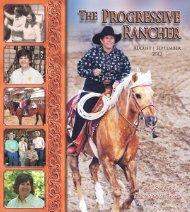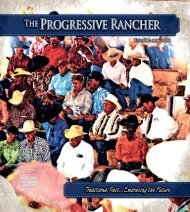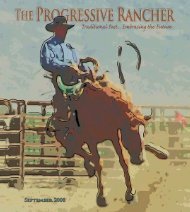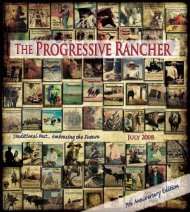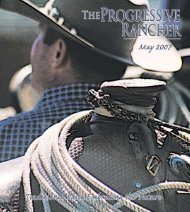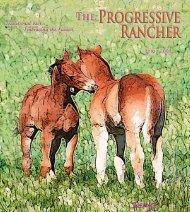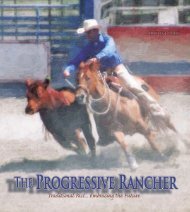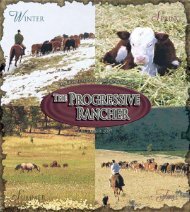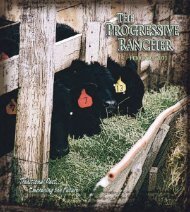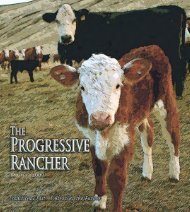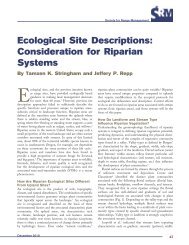NCA 2009 President's Award Recipient - The Progressive Rancher ...
NCA 2009 President's Award Recipient - The Progressive Rancher ...
NCA 2009 President's Award Recipient - The Progressive Rancher ...
You also want an ePaper? Increase the reach of your titles
YUMPU automatically turns print PDFs into web optimized ePapers that Google loves.
Spotted Knapweed appeared near Missoula before<br />
1925 and is now in every county in Montana.<br />
effect of the herbicide. Figure 2 shows the same spot one year later. <strong>The</strong> herbicide application<br />
eliminated over 99 percent of the seedlings and facilitated establishment of foxtail<br />
barley. Foxtail barley generally is not considered a desired species, but on a lakebed that<br />
is flooded every few years and has alkaline soil when exposed, foxtail barley probably is<br />
the best vegetation one can expect. At this location, cattle consume the foxtail barley quite<br />
readily in the fall and winter.<br />
<strong>The</strong> area shown in Figure 3 is about 200 yards from the location of Figures 1 and 2,<br />
and was inhabited by a very mature stand of perennial pepperweed. This site location was<br />
treated on the same day, and with the same chemical and application rate, as the perennial<br />
pepperweed seedlings shown in Figure 1. One year later there was no effective control of<br />
the mature perennial pepperweed plants (Figure 4). <strong>The</strong> mature stand of perennial pepperweed<br />
was eventually controlled (not eradicated), but it took several more annual treatments.<br />
One critical reason for successful control of the seedlings and unsuccessful control<br />
of the mature perennial pepperweed is the respective root structure of the different age<br />
classes. For about the first 6-8 eight weeks of growth, perennial pepperweed seedlings<br />
behave as an annual, not a perennial plant. <strong>The</strong> roots are short and they have not developed<br />
any perennial buds. <strong>The</strong> buds that develop on the root crown and the roots after eight weeks<br />
of age are what allow this weed to regrow the next year. When the leaves are killed before<br />
the seedling can develop perennial buds on the roots and root crown the plant dies. Mature<br />
perennial pepperweed plants have roots that extend several feet or more into the soil and<br />
can extend laterally for 10-20 feet or more. Every inch of these roots has developed a bud<br />
that can produce a new plant. It is literally impossible to place enough herbicide on the<br />
relatively small amount of leaf area of mature plants to kill all of the buds found on their<br />
very large root system. Some buds will survive and eventually produce stems that emerge<br />
the following growing season. Furthermore, emergence may not occur until the middle<br />
or latter part of the next growing season. Another challenge with applying herbicides to<br />
mature perennial pepperweed is appropriate location of the chemical. <strong>The</strong> lower leaves are<br />
the ones that export most of their carbohydrates from photosynthesis to the roots, and thus<br />
move the herbicide to the roots. <strong>The</strong> upper leaves deliver most of their energy production to<br />
the flowers and seed. It is very difficult to get herbicide, especially from an aerial application,<br />
through the flowers and upper leaves to the lower leaves, where it is most effective. As<br />
Figure 1 shows, all of the seedlings had leaves that were completely exposed and therefore<br />
had the maximum potential for herbicide contact, uptake and movement to the site of action<br />
in the plant. <strong>The</strong> work at Chimney Dam showed that perennial pepperweed up to two years<br />
old could be successfully treated with Cimaron ® Max provided their leaves were readily<br />
accessible to the herbicide. Complete documentation of the effort to control perennial peppewrweed<br />
at Chimeny Dam Reservoir can be found in two publications available on the<br />
internet at the URL addresses found at the end of this article.<br />
Papers described in the text. Please see these for additional discussion of this topic and<br />
photos of the success of the treatments applied.<br />
Schultz. B. W. 2012. <strong>The</strong> Noxious Weed Seedbank: Out of Sight – Out of mind and eventually<br />
out of control. UNCE Fact Sheet 12-01. Available at: http://www.unce.unr.edu/publications/<br />
search/details.asp?searchby=keywordsearch&searchtext=seedbank&submit=Search<br />
Schultz, B. W. 2012. Response of seedling and two-year-old perennial pepperweed (Lepidium<br />
latifolium) plants to herbicide control. Journal of the NACAA, Volume 5, Issue 1. May. Available<br />
at: http://www.nacaa.com/journal/index.php?jid=136.<br />
Schultz, B. W. 2011. Differential Herbicide Effectiveness on Adjacent Populations of Young<br />
(Seedling) And Mature Perennial Pepperweed (Lepidium latifolium). Journal of the NACAA.<br />
Volume 4, Issue 1. November. Available at: http://www.nacaa.com/journal/index.php?jid=103<br />
<strong>The</strong> use of herbicide names in this paper does not imply any recommendation from the University<br />
of Nevada Cooperative Extension. Perennial pepperweed can be treated successfully with a number of<br />
herbicides and any applicator should know the benefits and constraints of each herbicide and make their<br />
selection based upon their specific circumstances.<br />
Specializing In<br />
Long Term Farm & Ranch Real Estate Loans<br />
2420 Main St.<br />
Baker City, OR 97814<br />
Incredibly<br />
Comfortable<br />
Phone:<br />
775-738-9500<br />
Fax:<br />
775-753-7169<br />
Call Or Visit Today<br />
Toll Free: 800-444-7101<br />
Website: www. pacificim.net<br />
Furniture as<br />
as You Are!<br />
2990 Idaho St. Elko, NV 89801<br />
LEATHER:<br />
• Outlasts Fabric<br />
Four-To-One<br />
• Offers Year<br />
Round Comfort<br />
• Is Extremely<br />
Durable<br />
• Ages Well<br />
• Color Stays<br />
Vibrant<br />
• Is Easy To<br />
Care For<br />
La-z-boy Ashley Sunny Designs Serta Mattresses<br />
Hours:<br />
Mon-Fri<br />
8:30-5:30<br />
Saturday 9-5<br />
Closed<br />
Sundays<br />
www.progressiverancher.com <strong>The</strong> <strong>Progressive</strong> <strong>Rancher</strong><br />
April 2013 37



